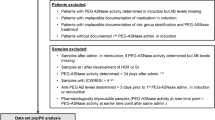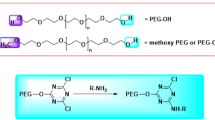ABSTRACT
An increasing number of pegylated therapeutic proteins and drug targeting compounds are being introduced in the clinic. Pegylation is intended to increase circulation time and to reduce an immunogenic response. Recently however a number of publications have appeared claiming that the polyethylene glycol (PEG) moiety of these products in itself may be immunogenic and that the induced anti-PEG antibodies are linked to enhanced blood clearance and reduced efficacy of the products. A critical review of the literature shows that most, if not all assays for anti-PEG antibodies are flawed and lack specificity. Also the biological effects induced by anti-PEG antibodies lack the characteristics of a bona fide antibody reaction. Standardization of the anti-PEG assays and the development of reference sera are urgently needed.
Similar content being viewed by others
Abbreviations
- ABC:
-
Accelerated blood clearance
- BSA:
-
Bovine serum albumin
- ELISA:
-
Enzyme linked immunosorbent assay
- EMA:
-
European medicines agency
- FDA:
-
Food and drug administration
- Ig:
-
Immunoglobulin
- OVA:
-
Ovalbumin
- pDNA:
-
Plasmid DNA
- PEG:
-
Polyethylene glycol
REFERENCES
Payne RW, Murphy BM, Manning MC. Product development issues for PEGylated proteins. Pharm Dev Technol. 2011;16(5):423–40.
Kang JS, Deluca PP, Lee KC. Emerging PEGylated drugs. Expert Opin Emerg Drugs. 2009;14(2):363–80.
Pasut G, Veronese FM. State of the art in PEGylation: the great versatility achieved after forty years of research. J Control Release. 2012;161(2):461–72.
Garay RP, El-Gewely R, Armstrong JK, Garratty G, Richette P. Antibodies against polyethylene glycol in healthy subjects and in patients treated with PEG-conjugated agents. Expert Opin Drug Deliv. 2012;9(11):1319–23.
Armstrong JK. The occurrence, induction, specificity and potential effect of antibodies against poly(ethylene glycol). In: Veronese FM, editor. PEGylated protein drugs: basic science and clinical applications [Internet]. Basel: Birkhäuser Basel; 2009 [cited 2012 Dec 14]. page 147–68. Available from: http://rd.springer.com/chapter/10.1007/978-3-7643-8679-5_9
Wang X, Ishida T, Kiwada H. Anti-PEG IgM elicited by injection of liposomes is involved in the enhanced blood clearance of a subsequent dose of PEGylated liposomes. J Control Release. 2007;119(2):236–44.
Richter AW, Akerblom E. Antibodies against polyethylene glycol produced in animals by immunization with monomethoxy polyethylene glycol modified proteins. Int Arch Allergy Appl Immunol. 1983;70(2):124–31.
Richter AW, Akerblom E. Polyethylene glycol reactive antibodies in man: titer distribution in allergic patients treated with monomethoxy polyethylene glycol modified allergens or placebo, and in healthy blood donors. Int Arch Allergy Appl Immunol. 1984;74(1):36–9.
Shimizu T, Ichihara M, Yoshioka Y, Ishida T, Nakagawa S, Kiwada H. Intravenous administration of polyethylene glycol-coated (PEGylated) proteins and PEGylated adenovirus elicits an anti-PEG immunoglobulin M response. Biol Pharm Bull. 2012;35(8):1336–42.
Su Y-C, Chen B-M, Chuang K-H, Cheng T-L, Roffler SR. Sensitive quantification of PEGylated compounds by second-generation anti-poly(ethylene glycol) monoclonal antibodies. Bioconjug Chem. 2010;21(7):1264–70.
Sherman MR, Williams LD, Sobczyk MA, Michaels SJ, Saifer MGP. Role of the methoxy group in immune responses to mPEG-protein conjugates. Bioconjug Chem. 2012;23(3):485–99.
Liu Y, Reidler H, Pan J, Milunic D, Qin D, Chen D, et al. A double antigen bridging immunogenicity ELISA for the detection of antibodies to polyethylene glycol polymers. J Pharmacol Toxicol Methods. 2011;64(3):238–45.
Wiberg M, Wang D, Yang L, Kamerud J. Detection of human anti-polyethylene glycol (PEG) antibodies: challenges for method development. http://www.aapsj.org/abstracts/AM_2010/T3292.pdf.
Garratty G. Progress in modulating the RBC membrane to produce transfusable universal/stealth donor RBCs. Transfus Med Rev. 2004;18(4):245–56.
Garratty G. Modulating the red cell membrane to produce universal/stealth donor red cells suitable for transfusion. Vox Sang. 2008;94(2):87–95.
Ganson NJ, Kelly SJ, Scarlett E, Sundy JS, Hershfield MS. Control of hyperuricemia in subjects with refractory gout, and induction of antibody against poly(ethylene glycol) (PEG), in a phase I trial of subcutaneous PEGylated urate oxidase. Arthritis Res Ther. 2006;8(1):R12.
Tillmann H, Ganson NJ, Patel K, Thompson AJ, Abdelmalek M, Moody T, et al. High prevalence of pre-existing antibodies against polyethylene glycol (PEG) in hepatitis C (HCV) patients which is not associated with impaired response to PEG-interferon. J Hepatol. 2010;52:S129.
Sroda K, Rydlewski J, Langner M, Kozubek A, Grzybek M, Sikorski AF. Repeated injections of PEG-PE liposomes generate anti-PEG antibodies. Cell Mol Biol Lett. 2005;10(1):37–47.
Tagami T, Uehara Y, Moriyoshi N, Ishida T, Kiwada H. Anti-PEG IgM production by siRNA encapsulated in a PEGylated lipid nanocarrier is dependent on the sequence of the siRNA. J Control Release. 2011;151(2):149–54.
Kaminskas LM, McLeod VM, Porter CJH, Boyd BJ. Differences in colloidal structure of PEGylated nanomaterials dictate the likelihood of accelerated blood clearance. J Pharm Sci. 2011;100(11):5069–77.
Zhang C, Fan K, Ma X, Wei D. Impact of large aggregated uricases and PEG diol on accelerated blood clearance of PEGylated canine uricase. PLoS One. 2012;7(6):e39659.
Goins B, Phillips WT, Klipper R. Repeat injection studies of technetium-99m-labeled peg-liposomes in the same animal. J Liposome Res. 1998;8:265–81.
Oussoren C, Storm G. Effect of repeated intravenous administration on circulation kinetics of poly(ethyleneglycol)-liposomes in rats. J Liposome Res. 1998;9:349–55.
Ishida T, Maeda R, Ichihara M, Irimura K, Kiwada H. Accelerated clearance of PEGylated liposomes in rats after repeated injections. J Control Release. 2003;88(1):35–42.
Laverman P, Carstens MG, Boerman OC, Dams ET, Oyen WJ, Van Rooijen N, et al. Factors affecting the accelerated blood clearance of polyethylene glycol-liposomes upon repeated injection. J Pharmacol Exp Ther. 2001;298(2):607–12.
Dams ET, Laverman P, Oyen WJ, Storm G, Scherphof GL, Van Der Meer JW, et al. Accelerated blood clearance and altered biodistribution of repeated injections of sterically stabilized liposomes. J Pharmacol Exp Ther. 2000;292(3):1071–9.
Ishida T, Wang X, Shimizu T, Nawata K, Kiwada H. PEGylated liposomes elicit an anti-PEG IgM response in a T cell-independent manner. J Control Release. 2007;122(3):349–55.
Schellekens H. How to predict and prevent the immunogenicity of therapeutic proteins. Biotechnol Annu Rev. 2008;14:191–202.
Judge A, McClintock K, Phelps JR, Maclachlan I. Hypersensitivity and loss of disease site targeting caused by antibody responses to PEGylated liposomes. Mol Ther. 2006;13(2):328–37.
Hamad I, Hunter AC, Szebeni J, Moghimi SM. Poly(ethylene glycol)s generate complement activation products in human serum through increased alternative pathway turnover and a MASP-2-dependent process. Mol Immunol. 2008;46(2):225–32.
Author information
Authors and Affiliations
Corresponding author
Rights and permissions
About this article
Cite this article
Schellekens, H., Hennink, W.E. & Brinks, V. The Immunogenicity of Polyethylene Glycol: Facts and Fiction. Pharm Res 30, 1729–1734 (2013). https://doi.org/10.1007/s11095-013-1067-7
Received:
Accepted:
Published:
Issue Date:
DOI: https://doi.org/10.1007/s11095-013-1067-7




